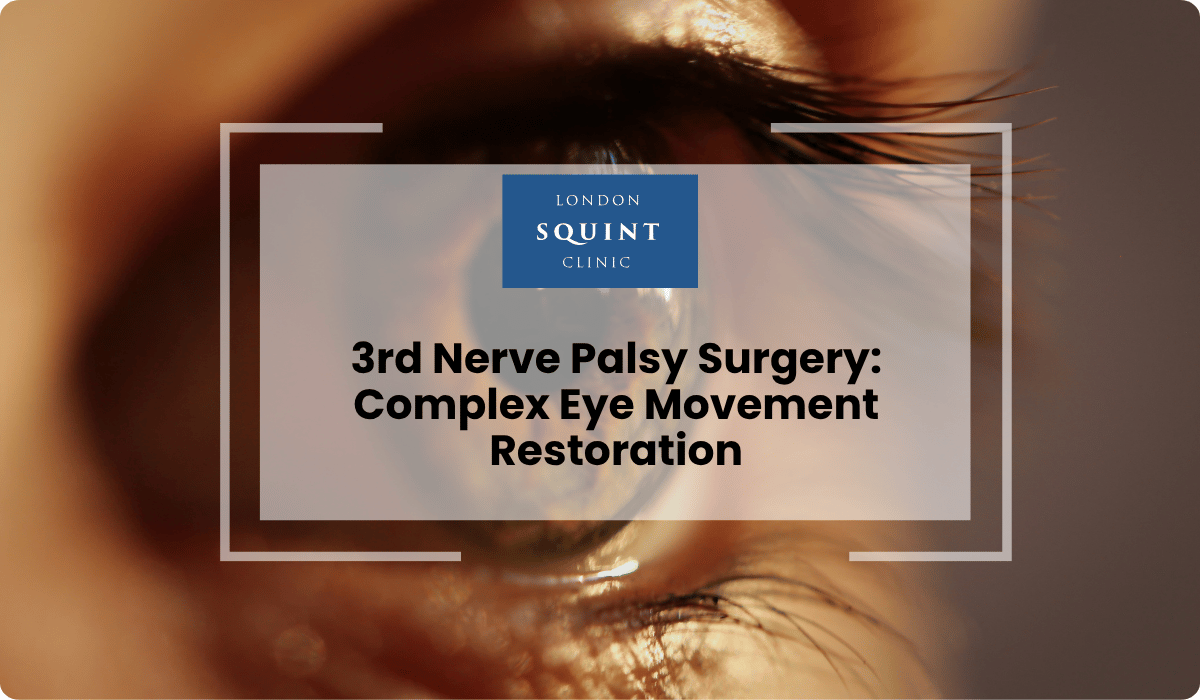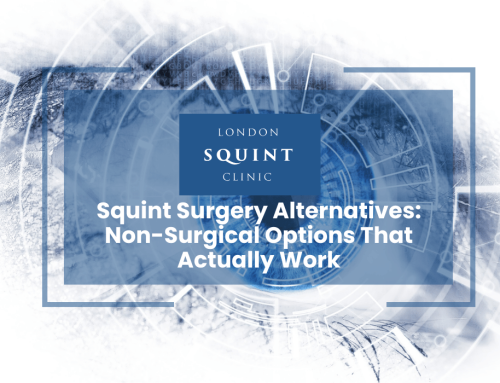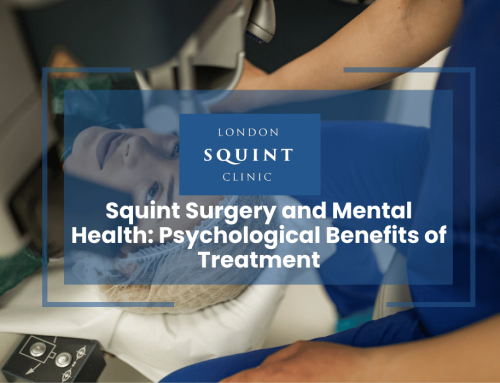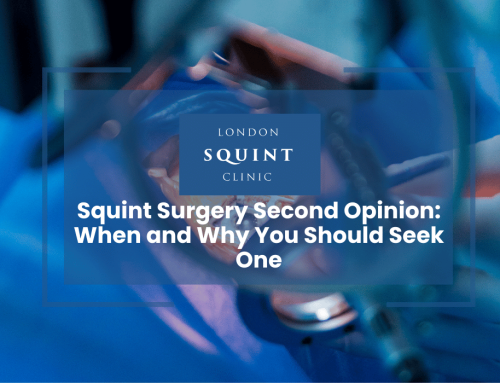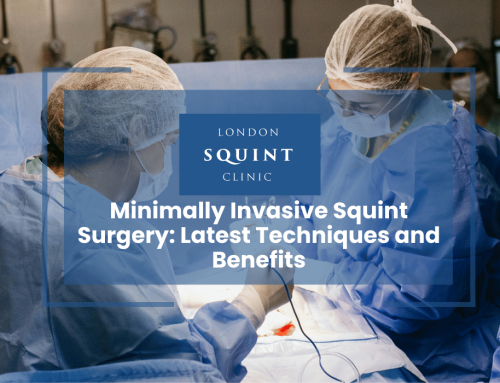3rd Nerve Palsy Surgery: Complex Eye Movement Restoration
3rd Nerve Palsy Surgery
- Third nerve palsy affects eye movement, eyelid function, and pupil constriction, with causes ranging from microvascular ischemia to trauma and aneurysms.
- Diagnosis requires comprehensive clinical examination and imaging studies, with pupil-involving cases needing urgent attention to rule out aneurysms.
- Surgical options include extraocular muscle procedures, ptosis correction, and fixation techniques, often performed in stages for optimal results.
- Recovery follows a predictable timeline from immediate post-operative discomfort to long-term adaptation, typically spanning 1-6 months.
- Non-surgical approaches like prism therapy, botulinum toxin injections, and vision therapy can complement surgical treatment or serve as alternatives.
- Success rates range from 70-85% for eye alignment and 60-75% for diplopia resolution, with outcomes depending on palsy completeness, duration, and patient factors.
- Choosing a specialist with specific expertise in complex strabismus and oculomotor disorders is crucial for optimal management of third nerve palsy.
Table of Contents
- Understanding 3rd Nerve Palsy: Causes and Symptoms
- Diagnosing Oculomotor Nerve Dysfunction: Assessment Process
- Surgical Options for Third Nerve Palsy Treatment
- What to Expect During 3rd Nerve Palsy Surgery Recovery?
- Non-Surgical Approaches to Managing Oculomotor Palsy
- Long-Term Outcomes and Success Rates of Surgical Intervention
- Choosing a Specialist for Complex Eye Movement Disorders
Understanding 3rd Nerve Palsy: Causes and Symptoms
Third nerve palsy, also known as oculomotor nerve palsy, is a complex neurological condition affecting eye movement and function. The oculomotor nerve (cranial nerve III) controls four of the six extraocular muscles that direct eye movement, the muscle that raises the eyelid (levator palpebrae superioris), and contributes to pupil constriction. When this nerve is damaged or dysfunctional, it results in a characteristic set of symptoms that significantly impact vision and appearance.
The most common causes of 3rd nerve palsy include:
- Microvascular ischaemia (often related to diabetes or hypertension)
- Compression from aneurysms, particularly of the posterior communicating artery
- Head trauma and brain injury
- Brain tumours or metastases
- Inflammatory conditions such as multiple sclerosis
- Infections including meningitis
- Congenital abnormalities
Patients with 3rd nerve palsy typically present with a constellation of symptoms including ptosis (drooping eyelid), outward and downward deviation of the eye (exotropia and hypotropia), limited eye movement, and diplopia (double vision). In cases where the pupillary fibres are affected (pupil-involving 3rd nerve palsy), the pupil may appear dilated and unresponsive to light, which can be a concerning sign potentially indicating compression from an aneurysm requiring urgent medical attention.
The severity of symptoms varies depending on whether the palsy is complete or partial. Complete palsy affects all functions of the nerve, while partial palsy may spare certain eye movements or pupillary function. Understanding the specific pattern of dysfunction is crucial for accurate diagnosis and appropriate treatment planning.
Diagnosing Oculomotor Nerve Dysfunction: Assessment Process
Accurate diagnosis of 3rd nerve palsy requires a comprehensive assessment process that combines detailed clinical examination with advanced imaging techniques. At the London Squint Clinic, our diagnostic approach begins with a thorough evaluation of eye movement, alignment, and pupillary function.
The clinical assessment typically includes:
- Detailed medical history to identify potential causes and risk factors
- Visual acuity testing to assess the impact on vision
- Examination of eye movements in all nine cardinal positions of gaze
- Measurement of the degree of strabismus (eye misalignment)
- Pupillary light reflex testing to determine if pupillary fibres are affected
- Eyelid function assessment to quantify ptosis
- Sensory testing to evaluate binocular vision and diplopia patterns
Imaging studies play a crucial role in identifying the underlying cause of oculomotor nerve dysfunction. These may include:
- Magnetic Resonance Imaging (MRI) of the brain and orbits to visualise the nerve pathway and identify structural abnormalities
- Magnetic Resonance Angiography (MRA) to detect aneurysms
- Computed Tomography (CT) scans, particularly in cases of trauma
- Cerebral angiography in selected cases where vascular causes are suspected
Laboratory investigations may also be conducted to identify systemic conditions that could contribute to nerve dysfunction, such as diabetes, hypertension, or inflammatory disorders. The diagnostic process is tailored to each patient’s presentation, with particular urgency given to cases where an aneurysm is suspected based on pupillary involvement.
This comprehensive assessment is essential for developing an appropriate treatment plan, as the management approach varies significantly depending on the underlying cause, severity, and duration of the palsy.
Surgical Options for Third Nerve Palsy Treatment
Surgical intervention for 3rd nerve palsy represents one of the most challenging areas of strabismus surgery, requiring specialised expertise and a tailored approach. At the London Squint Clinic, our surgical strategies are customised to address the specific pattern of muscle dysfunction in each patient.
The primary surgical options for third nerve palsy include:
Extraocular Muscle Surgery
This forms the cornerstone of surgical management and may involve several techniques:
- Muscle Recession and Resection: Adjusting the tension of functioning muscles to improve alignment
- Transposition Procedures: Repositioning functioning muscles to compensate for paralysed ones
- Adjustable Suture Techniques: Allowing fine-tuning of muscle position post-operatively
- Superior Oblique Tendon Transposition: Redirecting the function of the superior oblique muscle to assist with eye movement
Ptosis Correction
Addressing the drooping eyelid often requires:
- Frontalis Sling: Connecting the eyelid to the frontalis muscle to enable brow movement to lift the lid
- Levator Advancement: Tightening the dysfunctional levator muscle when some function remains
- Müller’s Muscle Resection: For cases with mild ptosis and good levator function
Fixation Procedures
In severe cases with minimal muscle function:
- Globe Fixation: Anchoring the eye in a primary position to prevent deviation
- Medial Rectus-Lateral Rectus Union: Joining these muscles to stabilise the eye position
The surgical approach often involves multiple procedures performed in stages. The initial surgery typically aims to achieve the best possible primary position alignment, with subsequent procedures addressing residual deviations and ptosis. In cases of complete 3rd nerve palsy, the goal is often functional improvement rather than restoration of full eye movement, focusing on establishing a stable, central eye position and relieving diplopia in the primary gaze.
Surgical planning requires careful consideration of the remaining muscle function, the pattern of eye deviation, and the patient’s visual needs. Advanced surgical techniques, including the use of adjustable sutures, allow for precise post-operative refinement of eye position to optimise outcomes in these challenging cases.
What to Expect During 3rd Nerve Palsy Surgery Recovery?
Recovery from 3rd nerve palsy surgery follows a predictable timeline, though individual experiences may vary based on the specific procedures performed and the patient’s overall health. Understanding the recovery process helps patients prepare mentally and physically for the post-operative period.
Immediate Post-Operative Period (1-7 days)
During the first week after surgery, patients can expect:
- Moderate discomfort and pain, managed with prescribed analgesics
- Significant eyelid swelling and bruising, which peaks at 48-72 hours
- Redness of the conjunctiva where muscles were adjusted
- Temporary blurred vision and light sensitivity
- If adjustable sutures were used, a follow-up appointment within 24 hours for final adjustments
- Regular application of prescribed antibiotic and anti-inflammatory eye drops
Early Recovery Phase (1-4 weeks)
As healing progresses, patients typically experience:
- Gradual resolution of swelling and bruising
- Improvement in comfort levels and reduced need for pain medication
- Stabilisation of vision and eye alignment
- Continued restriction from strenuous activities and swimming
- Follow-up appointments to monitor healing and alignment
Long-Term Recovery (1-6 months)
The final phase of recovery involves:
- Complete resolution of surgical swelling
- Adaptation to the new eye position
- Potential for visual therapy to improve binocular function
- Assessment for any need for additional procedures
- Gradual return to all normal activities
It’s important to note that while the cosmetic appearance often improves rapidly, the functional visual recovery may take longer as the brain adapts to the new eye position. Some patients may experience temporary worsening of double vision immediately after surgery before improvement occurs. This is normal and typically resolves as healing progresses.
Patients are advised to avoid rubbing the eyes, wear protective eyewear when outdoors, and follow all post-operative instructions carefully to optimise recovery. Regular follow-up appointments are essential to monitor progress and address any concerns promptly.
Non-Surgical Approaches to Managing Oculomotor Palsy
While surgery often plays a central role in the management of 3rd nerve palsy, non-surgical approaches are valuable both as initial interventions and as complementary treatments. These conservative measures can help manage symptoms, improve function, and in some cases, may be sufficient for patients with partial or recovering nerve function.
Observation and Monitoring
For acute cases of 3rd nerve palsy, particularly those caused by microvascular ischaemia (common in patients with diabetes or hypertension), a period of observation is often recommended as spontaneous recovery may occur within 3-6 months. During this time, regular assessments track any improvements in muscle function and eye alignment.
Optical Management
Several optical solutions can help manage visual symptoms:
- Prism Therapy: Fresnel prisms applied to spectacles can help realign images and reduce double vision
- Occlusion Therapy: Patching or fogging one lens to eliminate diplopia when prisms are not sufficient
- Specialised Glasses: Custom-designed spectacles that incorporate both prism correction and ptosis crutches
Botulinum Toxin Injections
Botulinum toxin (Botox) injections can be particularly useful in managing 3rd nerve palsy by:
- Weakening the unopposed lateral rectus muscle to reduce outward deviation
- Providing temporary alignment while awaiting spontaneous recovery
- Serving as a diagnostic tool to predict surgical outcomes
- Offering an alternative for patients who are not surgical candidates
Ptosis Management
For the drooping eyelid associated with 3rd nerve palsy:
- Ptosis Crutches: Attachments to spectacle frames that physically lift the eyelid
- Eyelid Tape: Temporary adhesive solutions for occasional use
Vision Therapy
Specialised exercises may help in cases with partial nerve function:
- Exercises to strengthen remaining muscle function
- Techniques to improve fusion and binocular vision
- Adaptation strategies to compensate for limited eye movement
These non-surgical approaches are often employed as initial management while determining whether the palsy will resolve spontaneously. They may also be valuable for patients who are not candidates for surgery due to medical comorbidities or in cases where complete surgical correction is not feasible due to the severity of nerve damage.
The optimal management plan typically involves a combination of these approaches, tailored to the individual patient’s needs, preferences, and clinical presentation. Regular reassessment is essential to monitor progress and adjust the treatment strategy as needed.
Long-Term Outcomes and Success Rates of Surgical Intervention
Understanding the expected outcomes and success rates of surgical intervention for 3rd nerve palsy is crucial for patients considering treatment options. It’s important to approach this with realistic expectations, as complete restoration of normal eye movement is often not achievable due to the complex nature of oculomotor nerve dysfunction.
Defining Surgical Success
In the context of 3rd nerve palsy surgery, success is typically measured by:
- Alignment of the eyes in primary (straight ahead) gaze
- Elimination or significant reduction of double vision in functional positions
- Improvement in ptosis with adequate eyelid opening
- Enhanced cosmetic appearance
- Patient satisfaction and quality of life improvement
Success Rates by Outcome Measure
Based on clinical studies and our experience at the London Squint Clinic:
- Primary Position Alignment: Approximately 70-85% of patients achieve satisfactory alignment in the primary position after surgical intervention
- Diplopia Resolution: About 60-75% of patients experience elimination of double vision in the primary position, though this may not extend to all gaze directions
- Ptosis Improvement: 80-90% of patients achieve functional eyelid elevation, though multiple procedures may be required
- Patient Satisfaction: Over 85% of patients report improved quality of life and satisfaction with the cosmetic outcome
Factors Affecting Outcomes
Several factors influence the likelihood of successful surgical correction:
- Completeness of Palsy: Partial palsies generally have better outcomes than complete palsies
- Duration: Chronic cases may have secondary changes in muscles and tissues that complicate correction
- Age:
Frequently Asked Questions
What is the most common cause of third nerve palsy?
The most common cause of third nerve palsy is microvascular ischaemia, particularly in patients with diabetes or hypertension. Other significant causes include compression from aneurysms (especially of the posterior communicating artery), head trauma, brain tumors, inflammatory conditions, and infections. The cause determines treatment approach and prognosis, with microvascular cases often showing spontaneous improvement over 3-6 months.
How urgent is medical attention for sudden onset third nerve palsy?
Sudden onset third nerve palsy with pupil involvement (dilated pupil) requires immediate medical attention as it may indicate a potentially life-threatening aneurysm. This is considered a neuro-ophthalmic emergency requiring urgent neuroimaging. Third nerve palsy without pupil involvement (pupil-sparing) is less urgent but still warrants prompt evaluation, typically within days, to determine the underlying cause.
Can third nerve palsy recover on its own without surgery?
Yes, third nerve palsy can recover spontaneously, particularly when caused by microvascular ischaemia (common in diabetic patients). Recovery typically occurs within 3-6 months. Approximately 80% of patients with microvascular third nerve palsy experience significant or complete recovery without surgical intervention. However, palsies caused by trauma, compression, or congenital factors are less likely to resolve spontaneously and may require surgical management.
What is the success rate of surgery for third nerve palsy?
The success rate of surgery for third nerve palsy varies depending on the outcome measure. Approximately 70-85% of patients achieve satisfactory alignment in primary gaze, 60-75% experience elimination of double vision in primary position, and 80-90% achieve functional eyelid elevation for ptosis. Complete restoration of normal eye movement in all directions is rarely achievable. Success rates are higher for partial palsies compared to complete palsies.
How many surgeries are typically needed to treat third nerve palsy?
Most patients with third nerve palsy require multiple surgeries for optimal results. Typically, 2-3 procedures are needed, often staged several months apart. The initial surgery usually focuses on achieving primary position alignment, while subsequent procedures address residual misalignment, ptosis, or fine-tuning of results. Complex cases with complete palsy may require additional procedures. The staged approach allows for healing and adaptation between surgeries.
What non-surgical options exist for managing double vision from third nerve palsy?
Non-surgical options for managing double vision from third nerve palsy include prism glasses (Fresnel prisms applied to spectacles), occlusion therapy (patching or fogging one lens), botulinum toxin injections to weaken the unopposed lateral rectus muscle, and specialized vision therapy. These approaches can be effective temporary measures while awaiting spontaneous recovery or as long-term solutions for patients who are not surgical candidates.
How do I choose the right specialist for third nerve palsy treatment?
When choosing a specialist for third nerve palsy treatment, look for a fellowship-trained neuro-ophthalmologist or strabismus surgeon with specific experience in complex ocular motility disorders. Verify their credentials, surgical volume for similar cases, and outcomes. The ideal specialist should practice at a center with access to multidisciplinary care (neurology, neurosurgery), offer both surgical and non-surgical management options, and demonstrate clear communication about realistic expectations and treatment plans.
Find out if you are suitable for Double Vision Treatment
Not everyone is eligible for double vision surgery.
Find out if you could benefit from this life-changing surgery by taking the quick self-suitability quiz below:
Our most popular procedures

Hello, I’m Nadeem Ali
I’m one of the few eye surgeons in the world with 100% focus on Squint and Double Vision Surgery.
I have 24 years of eye surgery experience, and worked for 13 years as a Consultant at London’s renowned Moorfields Eye Hospital.
In 2023, I left the NHS to focus fully on treating patients from across the world at the London Squint Clinic. You can read more about me here.
There’s lots of information on the website about: squint surgery, double vision surgery and our pricing.
The most rewarding part of my job is hearing patients tell me how squint or double vision surgery has changed their lives. You can hear these stories here.
Mr Nadeem Ali
MA MB BChir MRCOphth FRCSEd(Ophth)
